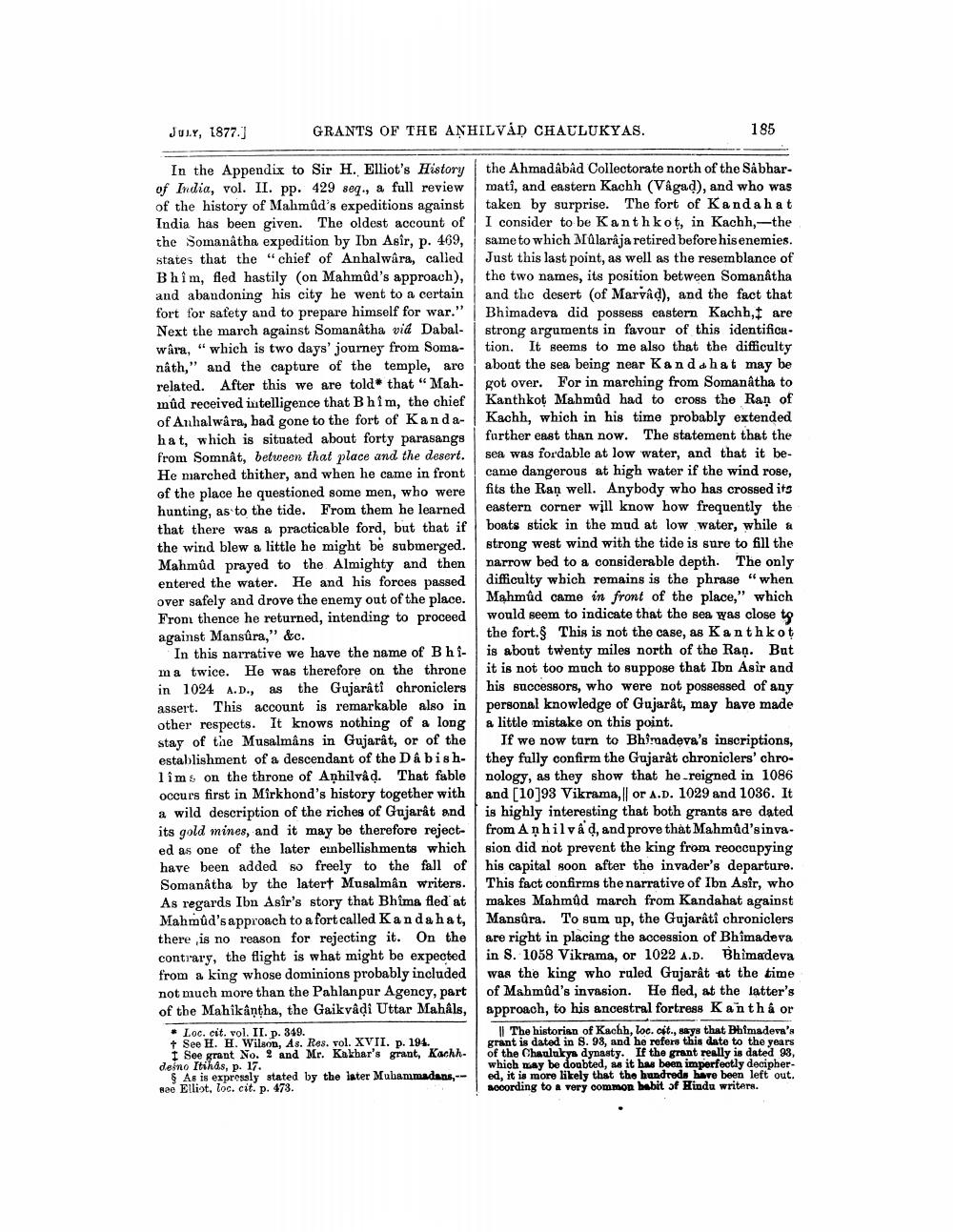________________
JULY, 1877.]
GRANTS OF THE AŅHILVÁD CHAULUKYAS.
185
In the Appendix to Sir H. Elliot's History of India, vol. II. pp. 429 seq., a full review of the history of Mahmûd's expeditions against India has been given. The oldest account of the Somanatha expedition by Ibn Asir, p. 469, states that the “chief of Anhalwâra, called Bhim, fled hastily (on Mahmûd's approach), and abandoning his city he went to a certain fort for safety and to prepare himself for war." Next the march against Somanatha vid Dabalwara, "which is two days' journey from Somanath," and the capture of the temple, are related. After this we are told that “Mahmûd received intelligence that Bhim, the chief of Anhalwara, bad gone to the fort of Kanda- hat, which is situated about forty parasange from Somnât, between that place and the desert. He marched thither, and when he came in front of the place he questioned some men, who were hunting, as to the tide. From them he learned that there was a practicable ford, but that if the wind blew a little he might be submerged. Mahmûd prayed to the Almighty and then entered the water. He and his forces passed over safely and drove the enemy out of the place. From thence he returned, intending to proceed against Mansûra," &c.
In this narrative we have the name of Bhi- ma twice. He was therefore on the throne in 1024 A.D., as the Gujarati chroniclers assert. This account is remarkable also in other respects. It knows nothing of a long stay of the Musalmans in Gujarât, or of the establishment of a descendant of the Dâ bish. lims on the throne of Anhilvad. That fable occurs first in Mirkhond's history together with a wild description of the riches of Gujarât and its gold mines, and it may be therefore reject ed as one of the later einbellishments which have been added 50 freely to the fall of Somanatha by the latert Musalman writers. As regards Ibn Asir's story that Bhima fled at Mahmûd's approach to a fort called Kanda hat, there is no reason for rejecting it. On the contrary, the flight is what might be expected from a king whose dominions probably included not much more than the Pahlanpur Agency, part of the Mahikântha, the Gaikyâdi Uttar Mahåls,
* Loc. cit. vol. II. p. 349. + See H. H. Wilson, As. Res. vol. XVII. p. 194.
I See grant No. 2 and Mr. Kakhar's grant, Kachhdesno Itihas, p. 17.
As is expressly stated by the later Muhammadans, -- see Elliot, loc. cit. p. 473.
the Ahmadâbâd Collectorate north of the Sábharmatî, and eastern Kachh (Vågad), and who was taken by surprise. The fort of Kanda hat I consider to be Kanth kot, in Kachh,—the same to which Mûlarâja retired before hisenemies. Just this last point, as well as the resemblance of the two names, its position between Somanatha and the desert (of Marvad), and the fact that Bhimadeva did possess castern Kachh, I are strong arguments in favour of this identification. It seems to me also that the difficulty about the sea being near Kandahat may be got over. For in marching from Somanatha to Kanthkot Mahmûd had to cross the Ran of Kachh, which in his time probably extended further east than now. The statement that the sea was fordable at low water, and that it became dangerous at high water if the wind rose, fits the Raņ well. Anybody who has crossed its eastern corner will know how frequently the boats stick in the mud at low water, while a strong west wind with the tide is sure to fill the narrow bed to a considerable depth. The only difficulty which remains is the phrase "when Mahmud came in front of the place," which would seem to indicate that the sea was close to the fort. This is not the case, as Kanth kot is about twenty miles north of the Ran. But it is not too much to suppose that Ibn Asir and his successors, who were not possessed of any personal knowledge of Gujarat, may have made a little mistake on this point.
If we now turn to Bhimadeva's inscriptions, they fully confirm the Gujarat chroniclers' chronology, as they show that he reigned in 1086 and [10]93 Vikrama, ll or A.D. 1029 and 1036. It is highly interesting that both grants are dated from Anhilva d, and prove that Mahmûd'sinvasion did not prevent the king from reoccupying his capital soon after the invader's departure. This fact confirms the narrative of Ibn Asir, who makes Mahmud march from Kandahat acainst. Mansura. To sum up, the Gujarati chroniclers are right in placing the accession of Bhimadera in S. 1058 Vikrama, or 1022 A.D. Bhimadeva was the king who ruled Gujarât at the time of Mahmûd's invasion. He fled, at the latter's approach, to his ancestral fortress Kantha or
|| The historian of Kachh, loc. cit., says that Bhimadeva's grant is dated in S. 98, and he refers this date to the years of the Chaulukys dynasty. If the grant really is dated 98, which may be doubted, as it has been imperfectly deciphered, it is more likely that the hundreds have been left out. according to a very common habit of Hindu writers.




